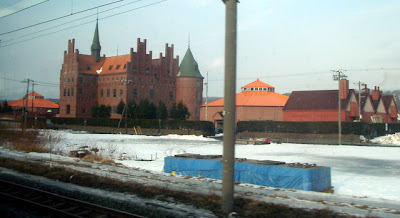 10th February, 2003 - Arrived in Hakodate... had curry rice (a local specialty), then started looking around town. Nearby the train station is one of the many fish markets where you will see all number of different types of sea life (at least I think that they're from Earth) that you wouldn't normally see back in Australia. Not being a natural sea-food person (and you married a Sapporo girl?!?!) it was all a bit strange to me.
10th February, 2003 - Arrived in Hakodate... had curry rice (a local specialty), then started looking around town. Nearby the train station is one of the many fish markets where you will see all number of different types of sea life (at least I think that they're from Earth) that you wouldn't normally see back in Australia. Not being a natural sea-food person (and you married a Sapporo girl?!?!) it was all a bit strange to me.
The one thing that we quickly discovered however was that T-chan's family weren't really the best people to ask regarding weather things... Hakodate was... well... FREEZING. The Japanese language is replete with many different ways to describe cold and snow etc... we invented another one. Ha-koDATE! (meaning - colder than you thought possible with a wind that goes right through your soul!). One of the first things we did was go shopping for gloves for T-chan.
 As mentioned previously, Hakodate has a special place in Japanese history as it was one of only a couple of ports that were initially opened up after the intervention of the US. However - it's also well known for the final battle ground of the Meiji Restoration. As the Tokugawa shogunate lost control of Japan in the 1850's - 1860's, there were a number of last ditched efforts to restore the previous order.
As mentioned previously, Hakodate has a special place in Japanese history as it was one of only a couple of ports that were initially opened up after the intervention of the US. However - it's also well known for the final battle ground of the Meiji Restoration. As the Tokugawa shogunate lost control of Japan in the 1850's - 1860's, there were a number of last ditched efforts to restore the previous order.  The last of these rebellions was known as the Boshin War, where a small army had formed a Ezo Republic (Yezo was the former name of Hokkaido) centred in Hakodate. The Imperial forces stormed the city, and routed the rebel army from Goryokaku fort... interestingly the last battle would not take place somewhere essentially Japanese - but rather one of the most westernised parts of Japan.
The last of these rebellions was known as the Boshin War, where a small army had formed a Ezo Republic (Yezo was the former name of Hokkaido) centred in Hakodate. The Imperial forces stormed the city, and routed the rebel army from Goryokaku fort... interestingly the last battle would not take place somewhere essentially Japanese - but rather one of the most westernised parts of Japan.  Goryokaku fort itself is a Japanese design based on European citadel towns, and was constructed in 1853 - the same year that Matthew Perry forced his way into Japan. It's a 5 pointed star design that was created to allow greater coverage of approaches by cannons. Despite the fact that whole fort is surrounded by a deep moat - you wonder about the value come winter - when it all freezes over. Having said that - it was a brave Japanese soldier to go campaigning in the winter time in Hokkaido. Nowadays the fort is an open public park, especially good for cherry blossom viewing.
Goryokaku fort itself is a Japanese design based on European citadel towns, and was constructed in 1853 - the same year that Matthew Perry forced his way into Japan. It's a 5 pointed star design that was created to allow greater coverage of approaches by cannons. Despite the fact that whole fort is surrounded by a deep moat - you wonder about the value come winter - when it all freezes over. Having said that - it was a brave Japanese soldier to go campaigning in the winter time in Hokkaido. Nowadays the fort is an open public park, especially good for cherry blossom viewing. You can pay about 840 yen to ascend the lookout Goryokaku Tower. Other than a reasonable vista of the fort (the only way to really appreciate the unique design) there's not much else to up there. In my opinion it's a bit pricey for what could be 5 mins of taking photos. Having said that - having come this far, you may as well. Nowadays there is a new tower (the one pictured below dates from the mid 1960's).
You can pay about 840 yen to ascend the lookout Goryokaku Tower. Other than a reasonable vista of the fort (the only way to really appreciate the unique design) there's not much else to up there. In my opinion it's a bit pricey for what could be 5 mins of taking photos. Having said that - having come this far, you may as well. Nowadays there is a new tower (the one pictured below dates from the mid 1960's).






.JPG)
























.JPG)